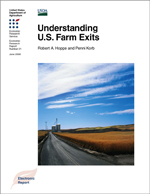Understanding U.S. Farm Exits
- by Robert A. Hoppe and Penni Korb
- 6/30/2006
Overview
The rate at which U.S. farms go out of business, or exit farming, is about 9 or 10 percent per year, comparable to exit rates for nonfarm small businesses in the United States. U.S. farms have not disappeared because the rate of entry into farming is nearly as high as the exit rate. The relatively stable farm count since the 1970s reflects exits and entries essentially in balance. The probability of exit is higher for recent entrants than for older, more established farms. Farms operated by Blacks are more likely to exit than those operated by Whites, but the gap between Black and White exit probabilities has declined substantially since the 1980s. Exit probabilities differ by specialization, with beef farms less likely to exit than cash grain or hog farms.
Download
-
Entire report
Download PDF -
Report summary
Download PDF -
Abstract, Acknowledgments, Contents, and Summary
Download PDF -
Introduction
Download PDF -
Background: Farm Exit Literature
Download PDF -
Source of Data
Download PDF -
The Model
Download PDF -
Results From the Base Model
Download PDF -
Additional Independent Variables
Download PDF -
Findings and Future Directions
Download PDF -
References
Download PDF -
Appendix I: 1997 Census of Agriculture Longitudinal File
Download PDF -
Appendix II: The Logistic Regression Model
Download PDF -
Appendix III: Farms With Sales of Less than $2,500 in the 1978 Census of Agriculture
Download PDF


